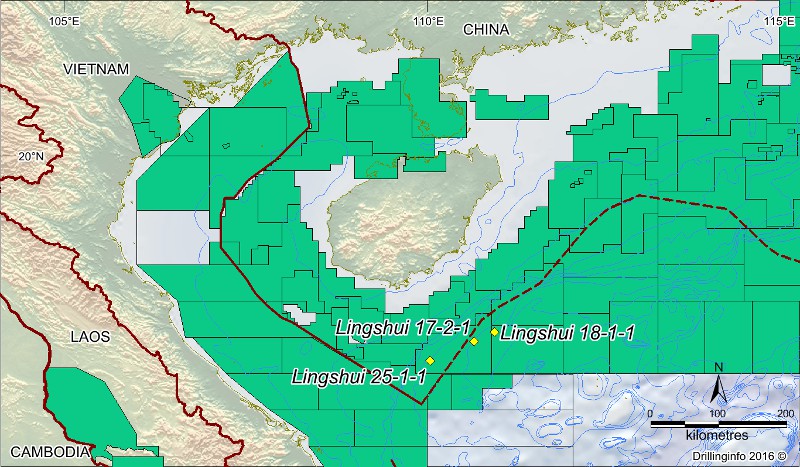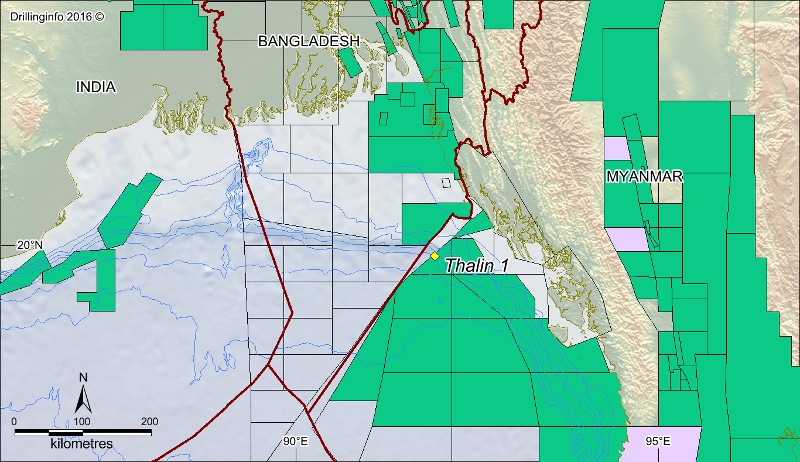China: First Ultra-Deepwater Discovery
 Qiongdongnan Basin in the north-western part of the South China Sea. (Source: DrillingInfo)In late February 2016, CNOOC confirmed Lingshui 18-1-1 as China’s first ultra-deepwater natural gas discovery. Located in the Lingshui 18 Block in the Qiongdongnan Basin in the north-western part of the South China Sea, the well flowed gas to the surface upon testing in early December 2015 and although the test rate has not been disclosed, the discovery has been certified by the Ministry of Land & Resources.
Qiongdongnan Basin in the north-western part of the South China Sea. (Source: DrillingInfo)In late February 2016, CNOOC confirmed Lingshui 18-1-1 as China’s first ultra-deepwater natural gas discovery. Located in the Lingshui 18 Block in the Qiongdongnan Basin in the north-western part of the South China Sea, the well flowed gas to the surface upon testing in early December 2015 and although the test rate has not been disclosed, the discovery has been certified by the Ministry of Land & Resources.
The exploration well was spudded on 21 October 2015 using the Haiyangshiyou 981 semi-submersible in 1,689m of water; an offshore well is considered ultradeep if it is drilled in waters over 1,500m deep. It reached a TD of 2,927m in mid-November 2015, and is thought to have been targeting the shaley sandstones of the Pliocene Yinggehai and Late Miocene Huangliu Formations. The gas flowing on test is believed to have come from the Second Member of the Yinggehai Formation.
Lingshui 18-1-1, operated by CNOOC, is located near another deep sea gas find, Lingshui 17-2, which has certified proven gas reserves exceeding 3.5 Tcf, as reported by the state media a year ago. This 2014 discovery well was drilled in 1,450m of water and reached a total depth of 3,510m, where it struck a 55m-thick reservoir.
Myanmar: New Play Opener
On 12 February 2016, Woodside Energy (Myanmar) Pte Ltd plugged and abandoned the Thalin 1 (also known as Thalyn 1) gas discovery, located in the 1,646 km2 Block AD-7 in 836m of water in the Bay of Bengal, about 100 km off the coast of Myanmar and less than 20 km from the maritime border with Bangladesh. The well encountered a 64m gross gas column, with 62m of net gas pay, interpreted to be within the primary objective, and it had been logged and pressure tested, confirming the presence of a gas column, before being abandoned.
 Thalin 1 in the northern part of the Rakhine Basin. (Source: Drillinginfo)Thalin 1, which is in the northern part of the Rakhine Basin, follows an earlier gas discovery by Woodside in the same basin at the Shwe Yee Htun-1 well in Block A-6, announced on 4 January this year. The two discoveries lie at opposite ends of the Rakhine Basin and the company believes that Thalin- 1A had successfully confirmed a working petroleum system whilst also proving a play type different to that encountered at Shwe Yee Htun-1. It lies approximately 60 km west of the Daewoo-operated producing Shwe Field, which has onshore gas plant and pipeline gas export facilities.
Thalin 1 in the northern part of the Rakhine Basin. (Source: Drillinginfo)Thalin 1, which is in the northern part of the Rakhine Basin, follows an earlier gas discovery by Woodside in the same basin at the Shwe Yee Htun-1 well in Block A-6, announced on 4 January this year. The two discoveries lie at opposite ends of the Rakhine Basin and the company believes that Thalin- 1A had successfully confirmed a working petroleum system whilst also proving a play type different to that encountered at Shwe Yee Htun-1. It lies approximately 60 km west of the Daewoo-operated producing Shwe Field, which has onshore gas plant and pipeline gas export facilities.
The well was spudded on 22 January 2016 using the Transocean Deepwater Millennium and drilled to a total depth of 3,034m. It is part of a one plus one option well drilling programme, with the option well planned for 2017.
Equity in Block AD-7 is split between Daewoo International Corp (60%) and Woodside (40%) with Woodside as the operator with respect to the deepwater drilling activities and Daewoo in charge of all other operations. In March 2014 the consortium acquired a 1,349 km2 3D seismic survey over the block, and after the block’s area was recently expanded north to the Myanmar maritime boundary, the AD-7 Joint Venture has approved the acquisition of an additional 1,200 km2 of 3D seismic data over this area, scheduled to commence in March 2016. This survey will facilitate further evaluation and expansion of the prospect portfolio.
Woodside is currently the largest acreage holder in the offshore Rakhine Basin, with interests in six blocks covering a total of about 47,000 km2.




